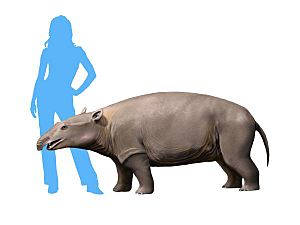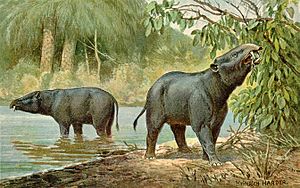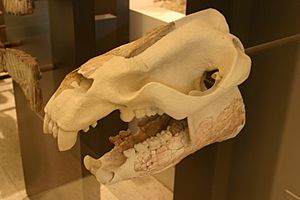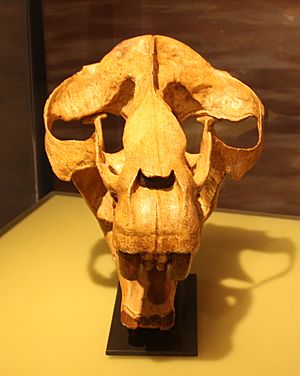Moeritherium facts for kids
Quick facts for kids MoeritheriumTemporal range: late Eocene
|
|
|---|---|
 |
|
| Skull of Moeritherium lyonsi in the Muséum National d'Histoire Naturelle, Paris | |
| Scientific classification | |
| Kingdom: | |
| Phylum: | |
| Class: | |
| Order: | |
| Family: |
†Moeritheriidae
C.W. Andrews, 1906
|
| Genus: |
†Moeritherium
C.W. Andrews, 1901
|
Moeritherium was an ancient mammal that lived a very long time ago. It is now extinct, meaning it no longer exists. This animal was an early relative of today's elephants. It is also distantly related to sea cows. Moeritherium lived during a time called the late Eocene epoch. This was about 37 to 35 million years ago. They lived in the area we now call North Africa.
Moeritherium looked quite different from modern elephants. It was about the size of a tapir. It had short, strong legs and a body that was fairly long. Its tail was short. The feet of Moeritherium were wide. They had flat, hoof-like toes.
Contents
What Moeritherium Looked Like
Moeritherium species were animals that looked a bit like pigs. They lived around 37 to 35 million years ago. They might remind you of modern tapirs or pygmy hippopotamuses. However, scientists do not believe they are closely related to these animals.
One species, M. lyonsi, was smaller than most later animals in the elephant family. It stood only about 70 centimeters (2.3 feet) tall at the shoulder. It weighed around 235 kilograms (518 pounds). That's about as heavy as a small horse.
The shape of their teeth tells us what they ate. Scientists think they ate soft plants that grew in water.
Did Moeritherium Have a Trunk?
The skull of Moeritherium gives us clues about its face. It probably did not have a long trunk like an elephant. Instead, it might have had a wide, flexible upper lip. This lip would have been like a tapir's. It would have helped Moeritherium grab plants from the water.
Their second incisor teeth grew into small tusks. These tusks looked more like a hippo's teeth than a modern elephant's.
How Moeritherium Was Discovered
In 1901, a scientist named Charles William Andrews described Moeritherium lyonsi. He found its fossil remains in Egypt. The fossils were in a place called the Qasr el Sagha Formation. This area is in Al Fayyum, Egypt.
In 1902, Andrews described another species, Moeritherium gracile. This was a smaller animal. Its fossils were found in the same area. They were in a place that used to be a river mouth or a salty lagoon.
Later, in 1904, the first fossils of Moeritherium trigodon were found. Charles Andrews discovered these in an oasis in Al Fayyum. Fossils of Moeritherium have also been found in other parts of North and West Africa.
In 1911, another scientist, Max Schlosser, divided Moeritherium lyonsi into two species. One was the large Moeritherium lyonsi from the Qasr-el-Sagha formation. The other was a new large species called M. andrewsi. This one came from the river-mouth area.
More recently, in 2006, Moeritherium chehbeurameuri was described. Its fossils were found in Algeria.
How Moeritherium Fits into the Elephant Family
Scientists do not think Moeritherium was a direct ancestor of modern elephants. Instead, it was a different branch of the Proboscidea group. This branch eventually died out. It did not leave any descendants that are alive today.
During the Eocene period, there were other early proboscideans. Some, like Phiomia and Palaeomastodon, looked more like modern elephants. However, Moeritherium was unique. It evolved in a different way. It had only a tapir-like flexible lip instead of a long trunk. It also had short legs.
See also
 In Spanish: Moeritherium para niños
In Spanish: Moeritherium para niños






